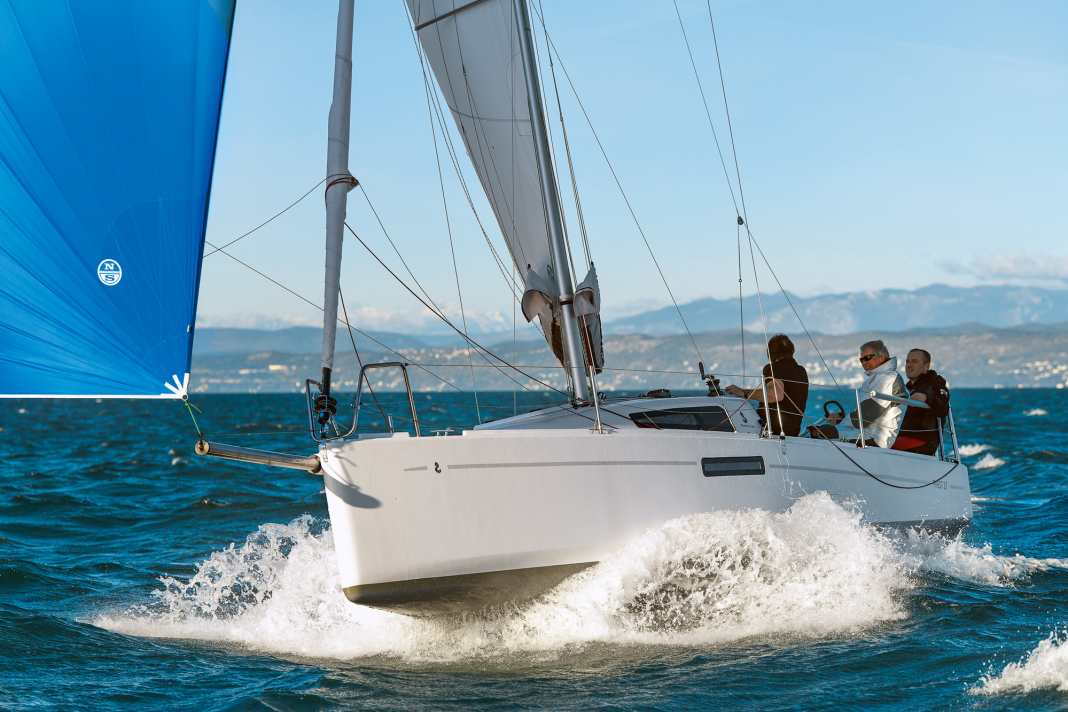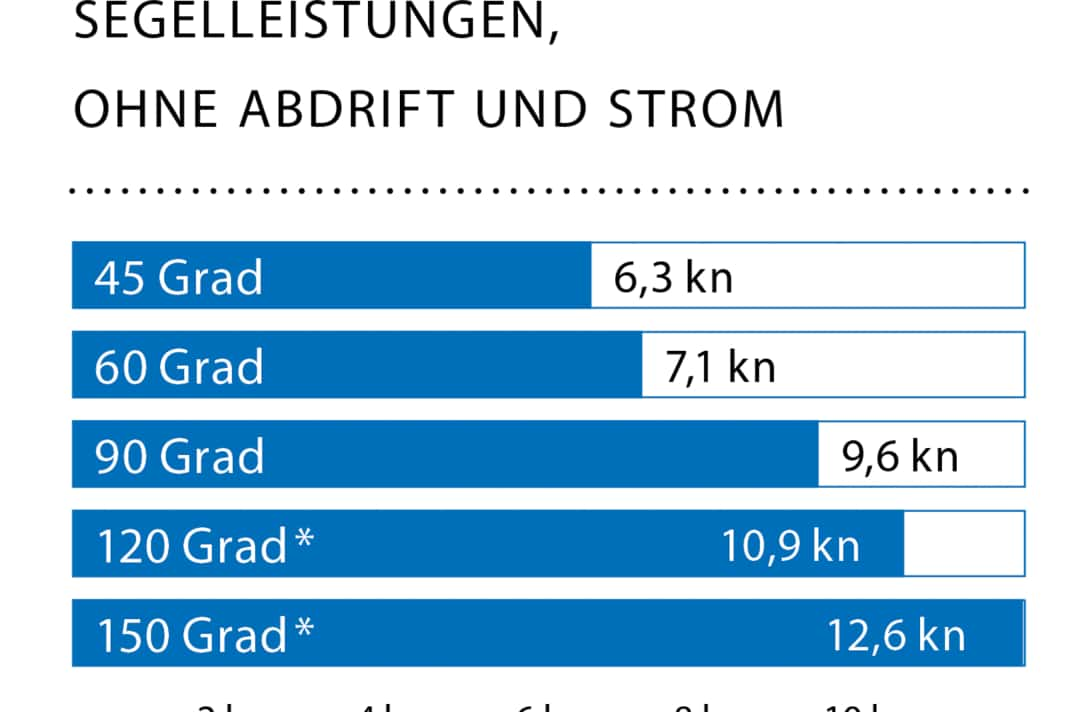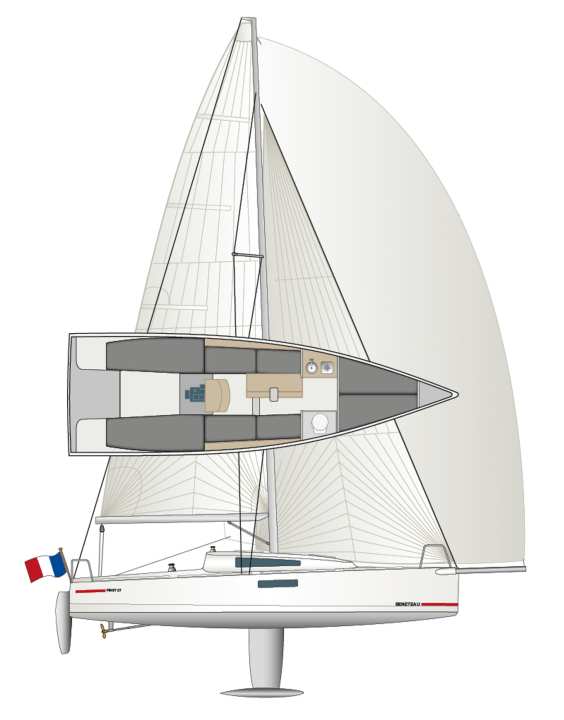





It is an irritatingly pithy greeting with which the First 27 welcomes its crew. A deep, calm pitching and rumbling sound emanates from the companionway into the cockpit. It is more reminiscent of old fishing boats than a modern performance cruiser in compact format. And indeed, the same archaic drive technology hums in the hull: a Yanmar diesel that doesn't really fit in with this speedster.
For a modern sports boat that displaces just 1.6 tonnes at a length of eight metres, this type of engine actually seems counter-indicative. And yet the 14 hp twin-cylinder is one of the most important features of the new First 27. Beneteau is trying to make the model attractive to as many owners as possible with the reliable diesel engine and a range of other equipment details.
The First 27 SE is the sporty basis
At its core, the First is a familiar and proven boat. First launched in 2012 as the Seascape 27, it became part of the First series when Beneteau took over the Slovenian shipyard. She initially retained her sporty, Spartan design.
However, the global market leader has since expanded its range. The original version remains as the First 27 SE and continues to enjoy unbroken popularity. It is complemented by the new boat, which is designed more for the needs of cruising sailors. A total of almost 250 units of the two 27s were built - an astonishing success in this segment.
You could call the First 27 a basic model, but that wouldn't really do the boat justice. Although it is cheaper, it is the more complete offering. This is probably one of the reasons why it has outperformed the SE in terms of sales figures in the two years since its market launch at the start of 2021.
The competition
It is not only the built-in diesel that distinguishes it from its fast sister, which comes without an engine and can be powered by an outboard motor in the shaft if desired. The two superstructure windows also set the new model apart at first glance. Their shape is reminiscent of the top model First Yacht 53, whose designer Lorenzo Argento worked on the lines. The long, flat windows make the boat appear even slimmer and more striking. They also create noticeably more light below deck and a better, more open feeling of space.
The benches in the originally empty cockpit are also new: they measure 1.37 metres in length and are 37 centimetres deep - sufficient for sitting, too short for sunbathing, but good for an additional 300 litres of storage space where you can use it best.
Rig geometry
Otherwise, the cockpit and fittings are largely the same as those of the sports version, which has already impressed in previous tests. There are only two differences: the mainsheet is not deflected to the centre of the cockpit, but is attached directly to the traveller mounted further aft, which results in slightly less favourable draft angles. And then there is a backstay for the first time.
This was not previously the case with Seascape sports boats due to the wide flared mainsail at the head. The First 27, however, has a classic, tapered main, which is set on an aluminium mast from Seldén. Consequently, a stay aft is possible and necessary here; the stiffer carbon rig of the 27 SE does not need this.
The rig geometry, on the other hand, is virtually identical. In fact, all the jibs have remained unchanged. If you wanted to, you could therefore also place the carbon fibre mast of the 27 SE on the First 27, which would result in a very attractive combination; however, it is not really necessary. The 27 SE carries a good eight square metres or 20 percent more cloth on the wind than the basic boat, mainly due to the fathead size. However, with a sail carrying capacity of 5.2, it is also undoubtedly a sporty boat.
A fixed keel under the hull counteracts this; the SE has a somewhat more efficient swivelling keel that can be raised and lowered hydraulically. The righting moment should be almost identical for both.
The design is also the same: the fin is made of lightweight GRP, the ballast is made of lead - not cast iron as is usual in series production, which keeps the centre of gravity low. In the First 27, the head of the fin is form-fit in a recess of the hull, where it is also bolted. A solid floor assembly absorbs the forces. Only a few production boatyards work in such an elaborate way, which proves once again that the boat builders in Slovenia have not taken any shortcuts when it comes to cruising boats.
Fiery maiden voyage
At the end of November, construction number 1 was available to us for two days for the test. Right at the start, a Bora provided 5 Beaufort from the north-east, and even more in gusts - conditions in which not only the Yanmar diesel was able to show what it can do.
To anticipate this: It has reassuring reserves to push the boat safely even against wind and short, steep waves. Originally, Beneteau had installed the single-cylinder 1YM10 with only 10 hp, which was also fitted to the prototype. Despite the folding propeller, it propelled the First at up to 6.9 knots at full load; at cruising speed, the GPS showed an average of 6.5 knots. Although the two-cylinder engine now fitted as standard adds around 30 kilos to the weight, it also delivers a whopping 50 per cent more power and runs much more smoothly. It should even make planing possible.
Under sail, the First 27 also detaches easily from its shaft system. On the first day of testing, she already exceeded her hull speed with the sheets shrouded and literally exploded on a half-wind course: Before you know it, the log shows 9 to 10 knots under main and jib only. And that's just the beginning.
On the square sheet under the 71 square metre gennaker, she surfed consistently in the double-digit range. Averaged over 500 metres, the First reached 12.6 knots without any hint of nervousness, and an impressive 15.4 knots at its peak. Only the short sea sometimes slowed down the forward momentum - namely when the boat stuck the bow into the slower-moving wave at full speed and a few hundred litres of water poured over the deck.
High stability
The boat was impressive even downwind. Steered carefully on the windward edge, it was able to carry a full load. This speaks for good rigidity, which was also evident in the harbour when walking across the side deck. With 39 per cent ballast, the First has reassuring stability reserves, which makes it more manoeuvrable than the sport version, which would have required the first reef and possibly also the staysail in the same conditions.
However, due to the smaller and less effective main, the sail pressure point is further forward than on the SE. This and the twin rudder system make for a very neutral steering feel - there is a lack of rudder pressure and therefore a lack of responsiveness. Consequently, if the wind continues to freshen, the genoa will first be furled a few turns before the first reef is tied into the main. This would require compensation strips on the luff of the headsail, which were missing on the test boat. The clew hole point and the cut were also not quite right; the mainsail had the cheapest of slides and a clew that was too low. However, shipyard founder Andraz Mihelin promises that this will be rectified for the start of series production.
On the second day, light winds between 5 and 10 knots provided a completely different kind of challenge - and the sports version sailed at the same time provided a good comparison. In such conditions, she can fully utilise her extra performance; she even slowly passes the First 27 from a leeward position. With a good half a knot more speed, a few degrees more height are also possible.
However, anyone who is not constantly travelling in windless areas and does not have a great ambition for regatta sailing will not find the difference painful. Even then, the standard version sails more agilely than the majority of boats around eight metres in length.
Light luxury
Below deck, the First 27 remains pragmatically simple thanks to its lightweight construction. However, with options such as a water tank, toilet, cockpit shower, pantry block and cool box, it is a real small yacht that lacks nothing essential apart from headroom. Sand-coloured textile upholstery and matching floor coverings even lend her a sense of cosiness. Compared to the minimalist design of the SE, it feels almost luxurious.
Adjusted for equipment, it is cheaper than its sporty sister - and cheaper than many of its competitors. Shipyard boss Andraz Mihelin therefore has high hopes for it: "I believe that it will be one of our most attractive models for years to come," he says. That doesn't require much prophecy.
The measured values for the test of the Beneteau First 27






The Beneteau First 27 in detail

Technical data of the Beneteau First 27
- Design engineer:Sam Manuard
- CE design category: B
- Torso length:7,99 m
- Waterline length:7,93 m
- Width: 2,54 m
- Depth:1,70 m
- Theoretical torso speed:6.8 kn
- Weight:1,6 t
- Ballast/proportion:0,63 t/39 %
- Mast height above waterline:12,20 m
- Mainsail:20,0 m2
- Furling genoa (105 %):17,3 m2
- Engine (two-cylinder Yanmar 2YM15): 10kW/14 PS
- Fuel tank:25 l
- Fresh water tank (optional):55 l
- Holding tank (opt.): 30
Hull and deck construction
GRP sandwich with foam core, laminated using vinyl ester resin in a vacuum infusion process. Fixed keel with GRP fin and lead bomb
Prices and shipyard
- Base price ex shipyard:98,320 € (incl. VAT)
- Guarantee/against osmosis:3/7 years
Prices as of 01/2024, as the prices shown are defined, you will find here !
Shipyard
Seascape d.o.o., Rjava cesta1a, 1260 Ljubljana Polje, Slovenia. info@thinkseascape.com
Distribution
dealer network: www.beneteau.com/de/das-beneteau-netzwerk
YACHT review of the Beneteau First 27
Not just a variant - with the First 27, Beneteau has developed a model in its own right. It hardly sails any less agile, but is much more accessible than its super-sporty sister
Design and concept
- + High-quality construction
- + Trailer bar, but not slipable
- + Clear, elongated lines
Sailing performance and trim
- + High speed potential
- + High stability range
- - Limited hole point adjustment
Living and finishing quality
- + Sufficient fitness to drive
- + Relatively comfortable berth dimensions
- - Rather sober ambience
Equipment and technology
- + Well dimensioned fittings
- + Useful extras
- - Scarce basic equipment
This article first appeared in YACHT 03/2021 and has been updated for this online version.

